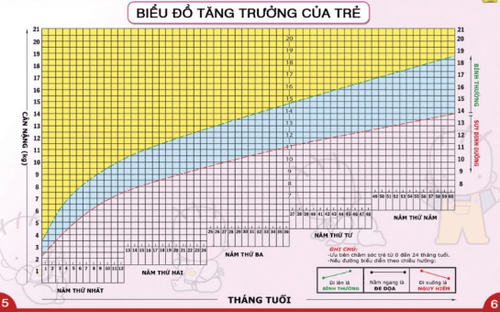This is an automatically translated article.
The article is professionally consulted by Master, Doctor Nguyen Thi An - Pediatrician - Neonatologist - Department of Pediatrics - Neonatology - Vinmec Ha Long International General Hospital.Monitoring the development of children is not only a job parents need to do, but this is really a job that many parents love. However, not everyone knows the full range of child development indicators to track, and you may not know how to measure them correctly.
1. What is growth? What growth is normal?
Physical growth is the increase in height, weight, and other bodily changes that occur as a child matures. Hair grows out; teething, tooth replacement, and finally puberty. All of these are part of the growth process.The growth in the first year of a baby may surprise you, where the average newborn grows about 10 inches (25 cm) in height and weighs three times their birth weight.
The development of a child after 1 year of age can make parents feel frustrated, when the child does not continue to grow so quickly. But no child continues to grow at the rate of infant growth.
After 1 year of age, the child's height growth slows down a bit. By age 2, growth in height usually continues at a fairly steady rate of about 2.5 inches (6cm) per year through adolescence.
However, no child develops at a completely steady rate throughout childhood. Several weeks or months of slightly slower growth alternate with minor growth spurts present in most children. Children actually tend to grow a little faster in the spring than at other times of the year.
Growth spurts occur during puberty, usually between 8 -13 years old in girls and 10 -15 years old in boys. Puberty lasts about 2 to 5 years. This growth is associated with sexual development, including the appearance of pubic and underarm hair, the growth and development of the sex organs, and, in girls, the onset of action. terrible .
By the time girls are 15 years old and boys are 16 or 17 years old, most of puberty has ended and they will have reached physical maturity.

Sự tăng trưởng trong năm đầu tiên của trẻ có thể khiến bạn kinh ngạc
2. What is a growth chart?
At each check-up, the doctor or nurse measures the baby's height, weight, and head circumference, and then marks those numbers on a chart that's within the normal range for babies of the same age and same age. sex with the baby. Finally, you will know which percentile your baby is in on the general growth chart.Growth chart shows the total growth of a child at a particular age. For example, the height chart for a 2-month-old girl shows a range from the shortest to the tallest. If your 2-month-old daughter is in the 50th percentile, that means she falls right in the middle and is the average length for her age.
If your baby was born prematurely, your doctor will take that into account by using your gestational age to plot your baby's numbers on a chart. For example, if a baby is born 4 weeks early, his numbers will be compared to full-term babies who are younger than 4 weeks.
Parents sometimes worry unnecessarily about these percentages. Percentage ratings in growth charts are not the same as school grades. A lower percentage rating doesn't mean something's wrong with your baby.
If both the mother and father of the baby are shorter than average and the baby grows up relatively short. It is perfectly normal for that child to consistently rank 10th in height as an adult.
Percentage measurements are a general guide to help you and your doctor assess your baby's growth. It is important that your baby's development is progressing according to its own chart.
Remember that each child is an individual and develops at his or her own pace. Children come in all shapes and sizes but are all healthy. Genetics, baby's activity level, health and nutrition problems are just some of the factors that can affect a child's growth.

Biểu đồ tăng trưởng của trẻ sinh non khác với trẻ bình thường
3. What do doctors use growth charts for?
Growth charts are part of a child's wellness check. They show how children are developing compared to other children of the same age and sex. They also show a pattern of a child's height and weight gain over time and whether the child is growing in proportion to that pattern.Each child follows a specific growth curve and the doctor will check to make sure the child's growth remains on that curve. The doctor also needs to make sure that the baby is gaining weight appropriately and monitor the baby's weight to make sure it's not too heavy for his height.
Instead of indicating your baby's growth percentage, your doctor will look at these measurements together to see your baby's overall growth pattern. Sometimes a natural or slowing growth rate can cause the numbers to shift slightly, but usually your child will be on the same percentile for height and weight as he or she grows.
Several different growth patterns can signal a problem. For example, if your child is on the 10th percentile for height and the 90th percentile for weight, his or her weight could be an issue. That is, the child is 10% taller than children of the same age, but he is heavier than 90% of the children of the same age.
The doctor may need to check to see why the child's weight and height are not matched. Your child may need help getting back to the right height-to-weight ratio.
Similarly, if the child is consistently in the 60th percentile for weight at all health screenings and then the next check finds the child in the 30th percentile for weight, the doctor You'll need to check to see if there's a reason your baby isn't growing the same way.
Doctors often use different growth charts, depending on the age of the child. The Centers for Disease Control and Prevention (CDC) recommends that doctors use the World Health Organization charts for the first two years of a baby's life to get the most current and accurate information. When a child is 2 years old, the doctor will likely use the CDC growth chart.
All charts show height in both inches and centimeters, and weight in both pounds and kilograms.

Biểu đồ tăng trưởng giúp đánh giá sự phát triển của trẻ sơ sinh
4. How does the doctor take the child's measurements?
Because a centimeter or a kilogram can make quite a difference in where on the growth chart is, babies are measured very carefully. It can be difficult to get accurate and reliable numbers, especially if children are very sensitive. But most doctors and nurses are experienced in taking baby measurements.The doctor or nurse will take three measurements of the baby, including:
Weight: After the baby is undressed, unswaddled, the doctor or nurse places the baby on the scale. Weight is measured in pounds to the nearest ounce or in kilograms to the nearest tenth of a kilogram. Height: The height measurement is taken while the baby is lying down, and the doctor or nurse will measure the child from the top of the head to the bottom of the heel. Head circumference: To measure a child's head circumference, the doctor or nurse places a soft tape measure where the largest circumference of the baby's head is, which is just above the eyebrows and ears, and around the back of the head the place is higher than the other part. Why is it important to monitor baby's head size? Because the size of the skull reflects the development of the brain. So, if your baby's brain isn't developing normally, his head circumference may not increase as it should. On the other hand, if the skull is growing too quickly, it could be a sign of a problem such as hydrocephalus (a buildup of fluid in the brain). Both conditions are unlikely, but still need to be ruled out.
An infant's head is larger and disproportionate compared to an adult's, so don't worry if your baby's head looks much larger than her body.

Trẻ được theo dõi cân nặng trong giai đoạn đầu chào đời
5. Is it possible to monitor a child's development at home?
You can completely monitor your child's development at home. However, your measurements may not be as accurate as what your doctor or nurse does. However, sometimes it's the parents who can spot growth problems earlier.You need to prepare the following items to measure the child's growth indicators:
A small scale: If you do not have a small scale, you can use any accurate scale any other is fine. It's very simple, you just need to hold your baby and step on the scale, record the weight of both you and your baby. Then put your baby down and on the scale alone. Subtract your weight from the previous weight and you will get your baby's weight. Height measure: You lay the child down and stretch the tape measure from the top of the head to the bottom of the heel. It's easiest if you ask someone for help as you need to gently straighten your baby's legs to do this. Your number may not be exactly with the doctor's number, but it will still help you keep track of your baby's growth. Soft tape measure: Wrap a soft tape measure around your baby's head just above your baby's eyebrows and ears, and around the back where the baby's head slopes up high above the neck. The goal is to measure the baby's head at the point where it has its greatest circumference. Once you have these measurements, use growth charting software or websites to compare your baby's growth with other children of the same age.
In the case of children with prolonged anorexia, malabsorption, and growth retardation, parents should supplement their children with supportive products containing lysine, essential micro-minerals and vitamins such as zinc, chromium, selenium, and B vitamins. help meet the nutritional needs of children. At the same time, these essential vitamins also support digestion, enhance nutrient absorption, help improve anorexia, and help children eat well. Parents can simultaneously apply dietary supplements and functional foods derived from nature for easy absorption. The most important thing is that improving your baby's symptoms often takes a long time. Combining many types of functional foods at the same time or changing many types in a short time can make the baby's digestive system unable to adapt and completely not good. Therefore, parents must be really patient with their children and regularly visit the website vimec.com to update useful baby care information.
References: babycenter.com, kidshealth.org,













